Cyberbullying: Mental Health, Counseling, and Research Report
VerifiedAdded on 2021/04/21
|16
|3934
|216
Report
AI Summary
This pre-proposal report delves into the pervasive issue of cyberbullying, examining its profound effects on the mental health of both teenagers and adults. It investigates the rise of online crimes and the factors that contribute to this phenomenon, particularly within the United States. The report also assesses various methods implemented to combat cyberbullying and their outcomes. The research problem focuses on the detrimental impact of cyberbullying on mental well-being and the potential of counseling as an intervention. The study employs a mixed-methods research design, combining qualitative and quantitative data collection to gain a comprehensive understanding of the issue. The literature review highlights the different forms of cyberbullying, its prevalence, and the psychological impact on victims. The research design includes a phenomenological approach to capture lived experiences, along with a data collection plan that involves surveys and focus groups. The research aims to identify effective prevention and control methods and proposes hypotheses to be tested through the collected data. Ethical and cultural considerations are also addressed. The study seeks to contribute to the development of effective counseling approaches and policies to reduce the incidence and negative effects of cyberbullying.
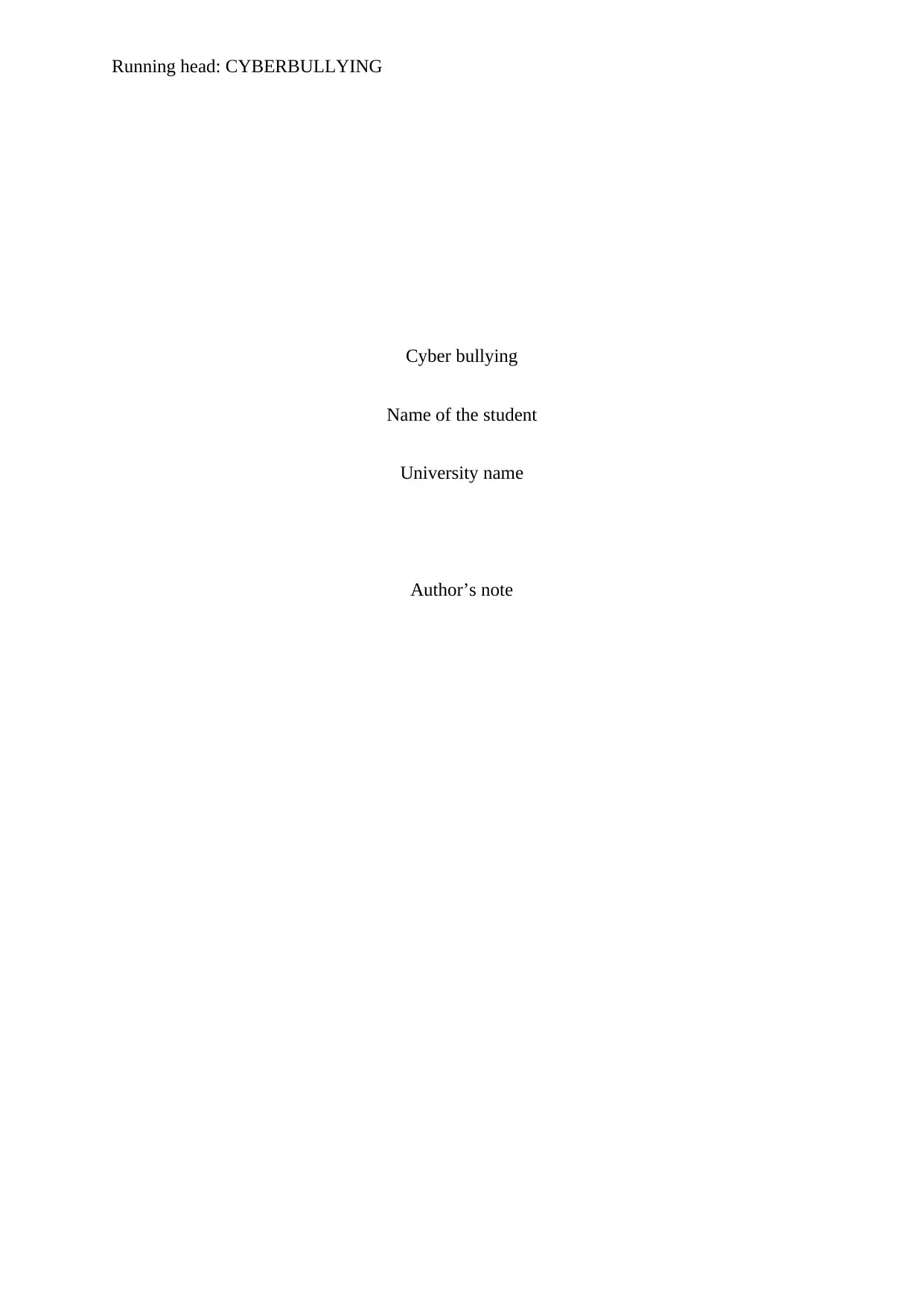
Running head: CYBERBULLYING
Cyber bullying
Name of the student
University name
Author’s note
Cyber bullying
Name of the student
University name
Author’s note
Paraphrase This Document
Need a fresh take? Get an instant paraphrase of this document with our AI Paraphraser
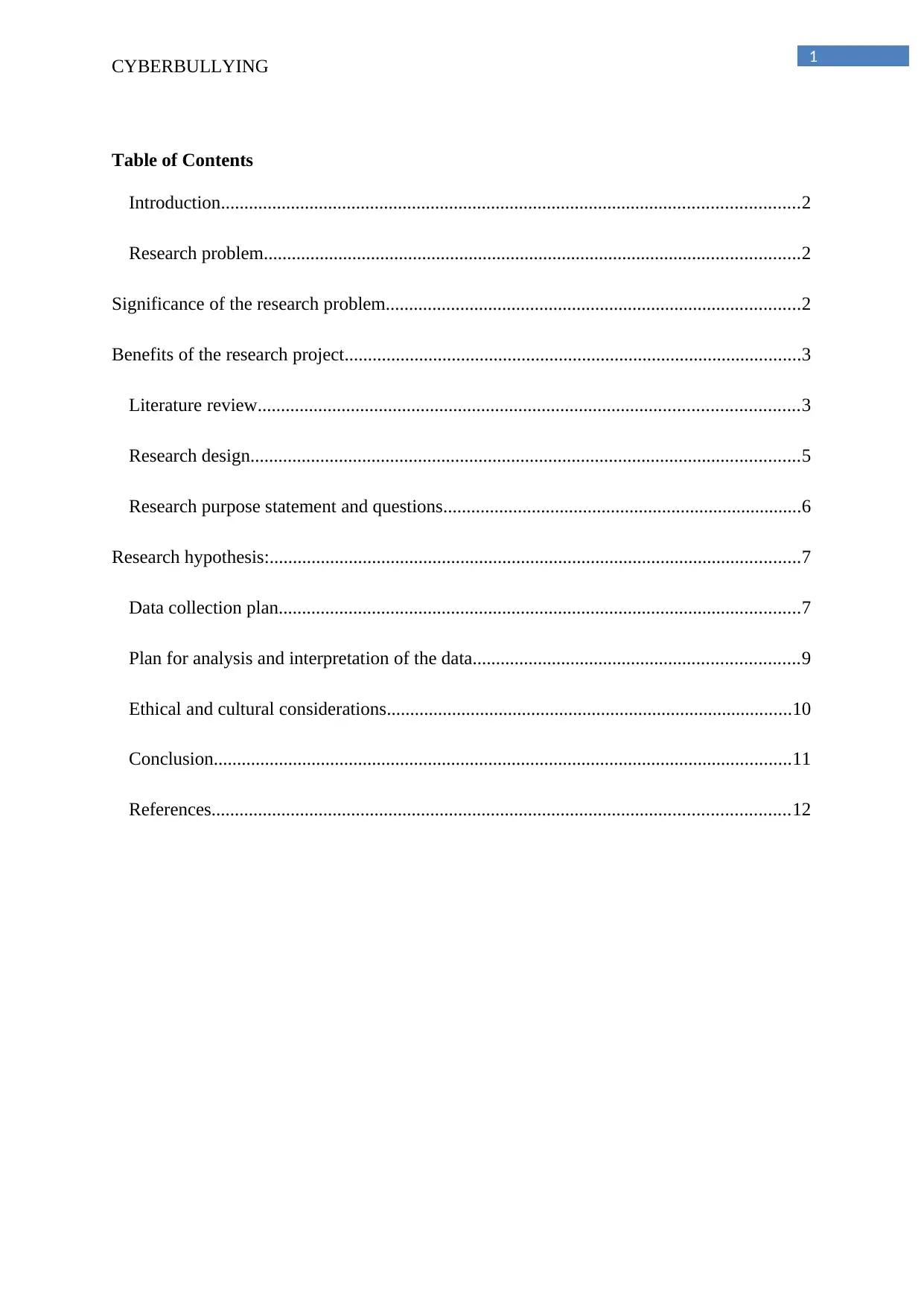
1
CYBERBULLYING
Table of Contents
Introduction............................................................................................................................2
Research problem...................................................................................................................2
Significance of the research problem.........................................................................................2
Benefits of the research project..................................................................................................3
Literature review....................................................................................................................3
Research design......................................................................................................................5
Research purpose statement and questions.............................................................................6
Research hypothesis:..................................................................................................................7
Data collection plan................................................................................................................7
Plan for analysis and interpretation of the data......................................................................9
Ethical and cultural considerations.......................................................................................10
Conclusion............................................................................................................................11
References............................................................................................................................12
CYBERBULLYING
Table of Contents
Introduction............................................................................................................................2
Research problem...................................................................................................................2
Significance of the research problem.........................................................................................2
Benefits of the research project..................................................................................................3
Literature review....................................................................................................................3
Research design......................................................................................................................5
Research purpose statement and questions.............................................................................6
Research hypothesis:..................................................................................................................7
Data collection plan................................................................................................................7
Plan for analysis and interpretation of the data......................................................................9
Ethical and cultural considerations.......................................................................................10
Conclusion............................................................................................................................11
References............................................................................................................................12
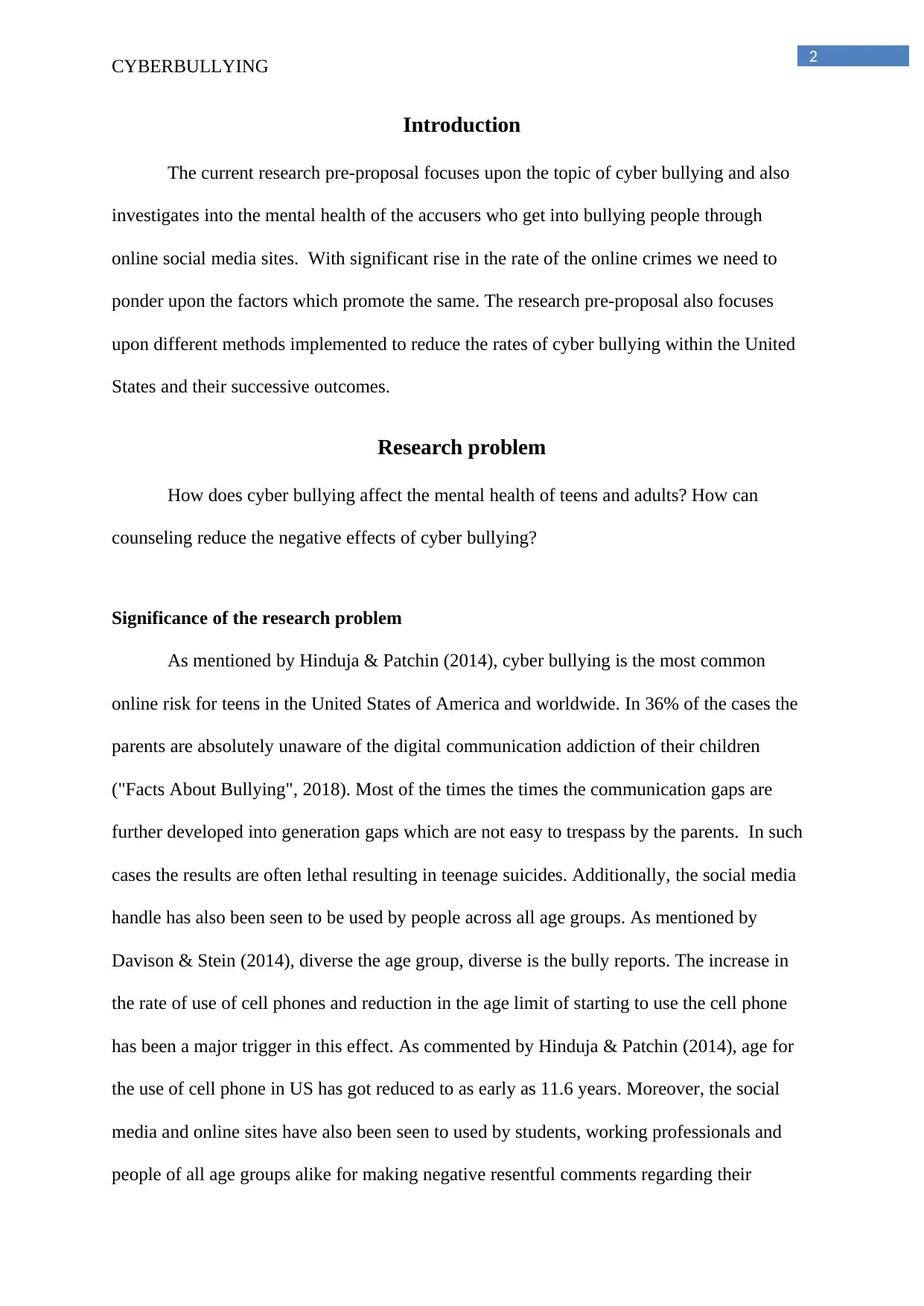
2
CYBERBULLYING
Introduction
The current research pre-proposal focuses upon the topic of cyber bullying and also
investigates into the mental health of the accusers who get into bullying people through
online social media sites. With significant rise in the rate of the online crimes we need to
ponder upon the factors which promote the same. The research pre-proposal also focuses
upon different methods implemented to reduce the rates of cyber bullying within the United
States and their successive outcomes.
Research problem
How does cyber bullying affect the mental health of teens and adults? How can
counseling reduce the negative effects of cyber bullying?
Significance of the research problem
As mentioned by Hinduja & Patchin (2014), cyber bullying is the most common
online risk for teens in the United States of America and worldwide. In 36% of the cases the
parents are absolutely unaware of the digital communication addiction of their children
("Facts About Bullying", 2018). Most of the times the times the communication gaps are
further developed into generation gaps which are not easy to trespass by the parents. In such
cases the results are often lethal resulting in teenage suicides. Additionally, the social media
handle has also been seen to be used by people across all age groups. As mentioned by
Davison & Stein (2014), diverse the age group, diverse is the bully reports. The increase in
the rate of use of cell phones and reduction in the age limit of starting to use the cell phone
has been a major trigger in this effect. As commented by Hinduja & Patchin (2014), age for
the use of cell phone in US has got reduced to as early as 11.6 years. Moreover, the social
media and online sites have also been seen to used by students, working professionals and
people of all age groups alike for making negative resentful comments regarding their
CYBERBULLYING
Introduction
The current research pre-proposal focuses upon the topic of cyber bullying and also
investigates into the mental health of the accusers who get into bullying people through
online social media sites. With significant rise in the rate of the online crimes we need to
ponder upon the factors which promote the same. The research pre-proposal also focuses
upon different methods implemented to reduce the rates of cyber bullying within the United
States and their successive outcomes.
Research problem
How does cyber bullying affect the mental health of teens and adults? How can
counseling reduce the negative effects of cyber bullying?
Significance of the research problem
As mentioned by Hinduja & Patchin (2014), cyber bullying is the most common
online risk for teens in the United States of America and worldwide. In 36% of the cases the
parents are absolutely unaware of the digital communication addiction of their children
("Facts About Bullying", 2018). Most of the times the times the communication gaps are
further developed into generation gaps which are not easy to trespass by the parents. In such
cases the results are often lethal resulting in teenage suicides. Additionally, the social media
handle has also been seen to be used by people across all age groups. As mentioned by
Davison & Stein (2014), diverse the age group, diverse is the bully reports. The increase in
the rate of use of cell phones and reduction in the age limit of starting to use the cell phone
has been a major trigger in this effect. As commented by Hinduja & Patchin (2014), age for
the use of cell phone in US has got reduced to as early as 11.6 years. Moreover, the social
media and online sites have also been seen to used by students, working professionals and
people of all age groups alike for making negative resentful comments regarding their
⊘ This is a preview!⊘
Do you want full access?
Subscribe today to unlock all pages.

Trusted by 1+ million students worldwide
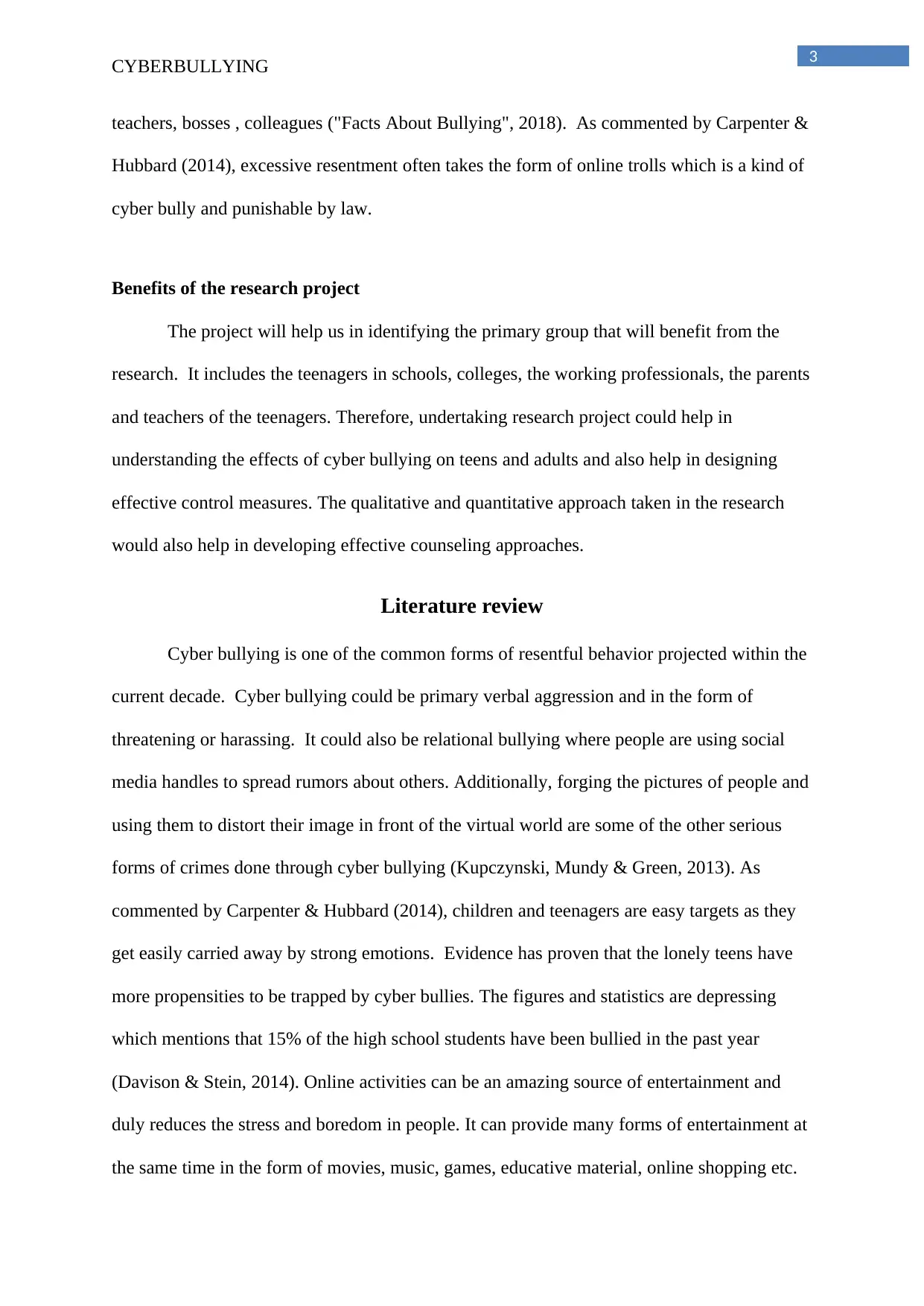
3
CYBERBULLYING
teachers, bosses , colleagues ("Facts About Bullying", 2018). As commented by Carpenter &
Hubbard (2014), excessive resentment often takes the form of online trolls which is a kind of
cyber bully and punishable by law.
Benefits of the research project
The project will help us in identifying the primary group that will benefit from the
research. It includes the teenagers in schools, colleges, the working professionals, the parents
and teachers of the teenagers. Therefore, undertaking research project could help in
understanding the effects of cyber bullying on teens and adults and also help in designing
effective control measures. The qualitative and quantitative approach taken in the research
would also help in developing effective counseling approaches.
Literature review
Cyber bullying is one of the common forms of resentful behavior projected within the
current decade. Cyber bullying could be primary verbal aggression and in the form of
threatening or harassing. It could also be relational bullying where people are using social
media handles to spread rumors about others. Additionally, forging the pictures of people and
using them to distort their image in front of the virtual world are some of the other serious
forms of crimes done through cyber bullying (Kupczynski, Mundy & Green, 2013). As
commented by Carpenter & Hubbard (2014), children and teenagers are easy targets as they
get easily carried away by strong emotions. Evidence has proven that the lonely teens have
more propensities to be trapped by cyber bullies. The figures and statistics are depressing
which mentions that 15% of the high school students have been bullied in the past year
(Davison & Stein, 2014). Online activities can be an amazing source of entertainment and
duly reduces the stress and boredom in people. It can provide many forms of entertainment at
the same time in the form of movies, music, games, educative material, online shopping etc.
CYBERBULLYING
teachers, bosses , colleagues ("Facts About Bullying", 2018). As commented by Carpenter &
Hubbard (2014), excessive resentment often takes the form of online trolls which is a kind of
cyber bully and punishable by law.
Benefits of the research project
The project will help us in identifying the primary group that will benefit from the
research. It includes the teenagers in schools, colleges, the working professionals, the parents
and teachers of the teenagers. Therefore, undertaking research project could help in
understanding the effects of cyber bullying on teens and adults and also help in designing
effective control measures. The qualitative and quantitative approach taken in the research
would also help in developing effective counseling approaches.
Literature review
Cyber bullying is one of the common forms of resentful behavior projected within the
current decade. Cyber bullying could be primary verbal aggression and in the form of
threatening or harassing. It could also be relational bullying where people are using social
media handles to spread rumors about others. Additionally, forging the pictures of people and
using them to distort their image in front of the virtual world are some of the other serious
forms of crimes done through cyber bullying (Kupczynski, Mundy & Green, 2013). As
commented by Carpenter & Hubbard (2014), children and teenagers are easy targets as they
get easily carried away by strong emotions. Evidence has proven that the lonely teens have
more propensities to be trapped by cyber bullies. The figures and statistics are depressing
which mentions that 15% of the high school students have been bullied in the past year
(Davison & Stein, 2014). Online activities can be an amazing source of entertainment and
duly reduces the stress and boredom in people. It can provide many forms of entertainment at
the same time in the form of movies, music, games, educative material, online shopping etc.
Paraphrase This Document
Need a fresh take? Get an instant paraphrase of this document with our AI Paraphraser
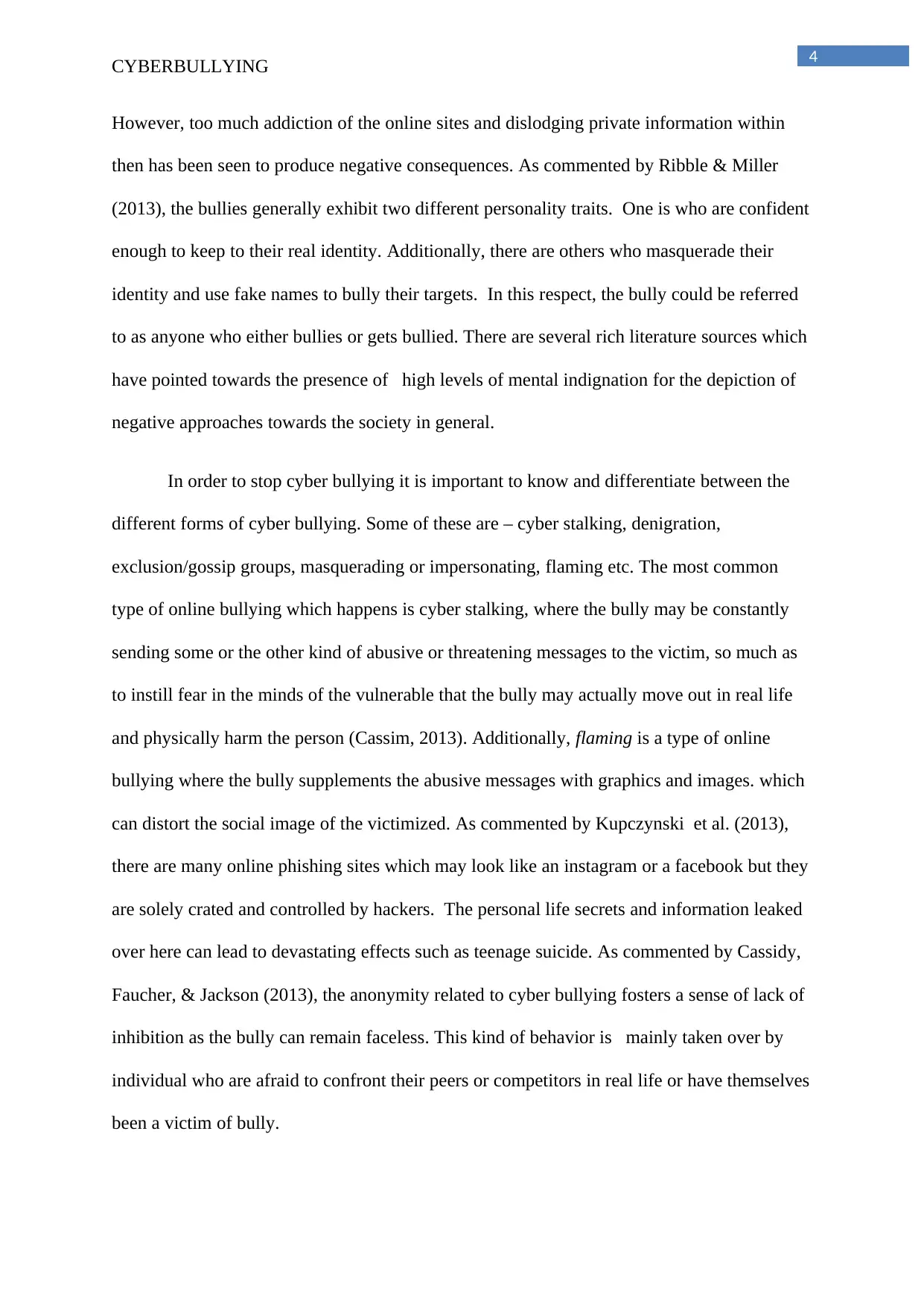
4
CYBERBULLYING
However, too much addiction of the online sites and dislodging private information within
then has been seen to produce negative consequences. As commented by Ribble & Miller
(2013), the bullies generally exhibit two different personality traits. One is who are confident
enough to keep to their real identity. Additionally, there are others who masquerade their
identity and use fake names to bully their targets. In this respect, the bully could be referred
to as anyone who either bullies or gets bullied. There are several rich literature sources which
have pointed towards the presence of high levels of mental indignation for the depiction of
negative approaches towards the society in general.
In order to stop cyber bullying it is important to know and differentiate between the
different forms of cyber bullying. Some of these are – cyber stalking, denigration,
exclusion/gossip groups, masquerading or impersonating, flaming etc. The most common
type of online bullying which happens is cyber stalking, where the bully may be constantly
sending some or the other kind of abusive or threatening messages to the victim, so much as
to instill fear in the minds of the vulnerable that the bully may actually move out in real life
and physically harm the person (Cassim, 2013). Additionally, flaming is a type of online
bullying where the bully supplements the abusive messages with graphics and images. which
can distort the social image of the victimized. As commented by Kupczynski et al. (2013),
there are many online phishing sites which may look like an instagram or a facebook but they
are solely crated and controlled by hackers. The personal life secrets and information leaked
over here can lead to devastating effects such as teenage suicide. As commented by Cassidy,
Faucher, & Jackson (2013), the anonymity related to cyber bullying fosters a sense of lack of
inhibition as the bully can remain faceless. This kind of behavior is mainly taken over by
individual who are afraid to confront their peers or competitors in real life or have themselves
been a victim of bully.
CYBERBULLYING
However, too much addiction of the online sites and dislodging private information within
then has been seen to produce negative consequences. As commented by Ribble & Miller
(2013), the bullies generally exhibit two different personality traits. One is who are confident
enough to keep to their real identity. Additionally, there are others who masquerade their
identity and use fake names to bully their targets. In this respect, the bully could be referred
to as anyone who either bullies or gets bullied. There are several rich literature sources which
have pointed towards the presence of high levels of mental indignation for the depiction of
negative approaches towards the society in general.
In order to stop cyber bullying it is important to know and differentiate between the
different forms of cyber bullying. Some of these are – cyber stalking, denigration,
exclusion/gossip groups, masquerading or impersonating, flaming etc. The most common
type of online bullying which happens is cyber stalking, where the bully may be constantly
sending some or the other kind of abusive or threatening messages to the victim, so much as
to instill fear in the minds of the vulnerable that the bully may actually move out in real life
and physically harm the person (Cassim, 2013). Additionally, flaming is a type of online
bullying where the bully supplements the abusive messages with graphics and images. which
can distort the social image of the victimized. As commented by Kupczynski et al. (2013),
there are many online phishing sites which may look like an instagram or a facebook but they
are solely crated and controlled by hackers. The personal life secrets and information leaked
over here can lead to devastating effects such as teenage suicide. As commented by Cassidy,
Faucher, & Jackson (2013), the anonymity related to cyber bullying fosters a sense of lack of
inhibition as the bully can remain faceless. This kind of behavior is mainly taken over by
individual who are afraid to confront their peers or competitors in real life or have themselves
been a victim of bully.
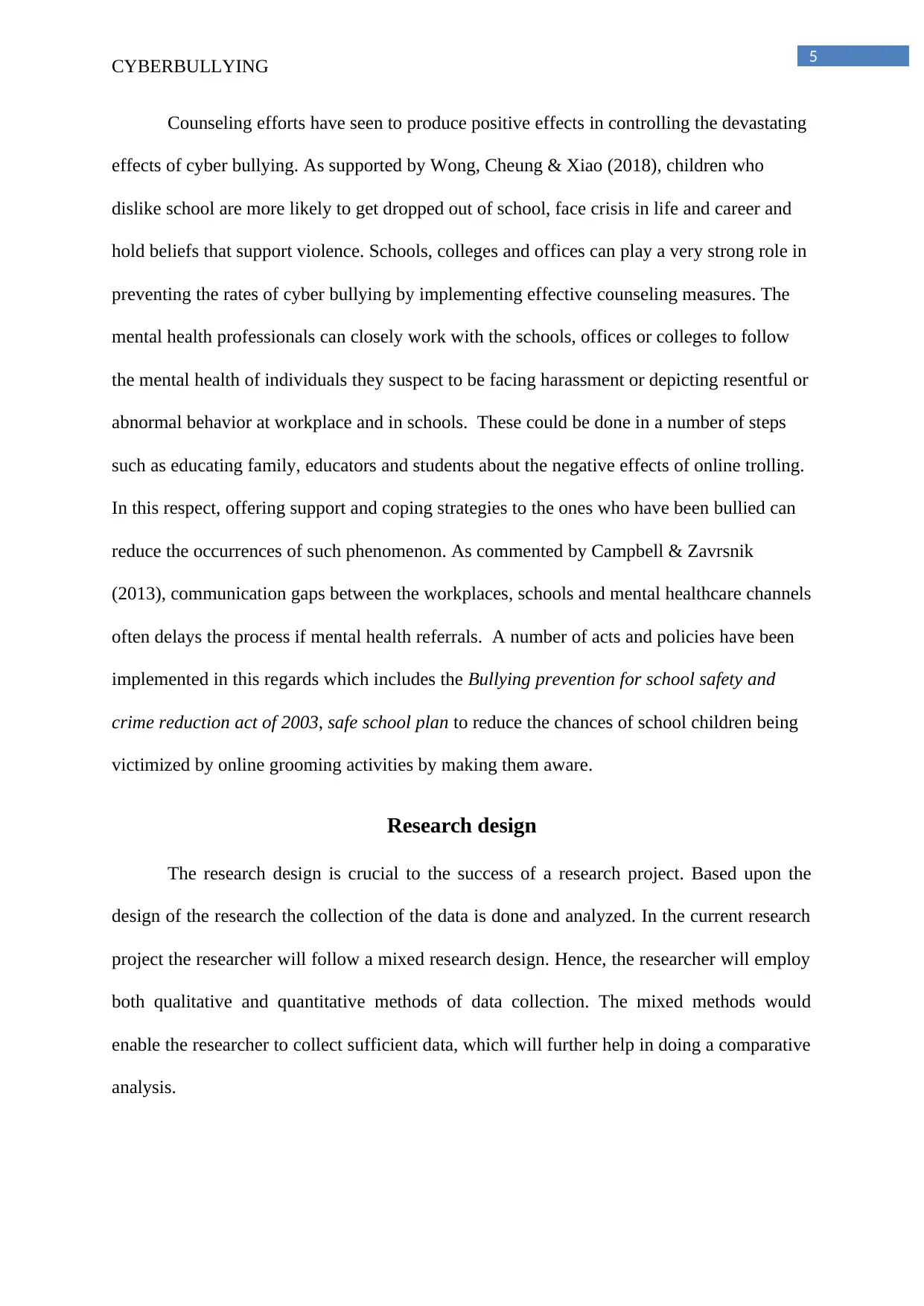
5
CYBERBULLYING
Counseling efforts have seen to produce positive effects in controlling the devastating
effects of cyber bullying. As supported by Wong, Cheung & Xiao (2018), children who
dislike school are more likely to get dropped out of school, face crisis in life and career and
hold beliefs that support violence. Schools, colleges and offices can play a very strong role in
preventing the rates of cyber bullying by implementing effective counseling measures. The
mental health professionals can closely work with the schools, offices or colleges to follow
the mental health of individuals they suspect to be facing harassment or depicting resentful or
abnormal behavior at workplace and in schools. These could be done in a number of steps
such as educating family, educators and students about the negative effects of online trolling.
In this respect, offering support and coping strategies to the ones who have been bullied can
reduce the occurrences of such phenomenon. As commented by Campbell & Zavrsnik
(2013), communication gaps between the workplaces, schools and mental healthcare channels
often delays the process if mental health referrals. A number of acts and policies have been
implemented in this regards which includes the Bullying prevention for school safety and
crime reduction act of 2003, safe school plan to reduce the chances of school children being
victimized by online grooming activities by making them aware.
Research design
The research design is crucial to the success of a research project. Based upon the
design of the research the collection of the data is done and analyzed. In the current research
project the researcher will follow a mixed research design. Hence, the researcher will employ
both qualitative and quantitative methods of data collection. The mixed methods would
enable the researcher to collect sufficient data, which will further help in doing a comparative
analysis.
CYBERBULLYING
Counseling efforts have seen to produce positive effects in controlling the devastating
effects of cyber bullying. As supported by Wong, Cheung & Xiao (2018), children who
dislike school are more likely to get dropped out of school, face crisis in life and career and
hold beliefs that support violence. Schools, colleges and offices can play a very strong role in
preventing the rates of cyber bullying by implementing effective counseling measures. The
mental health professionals can closely work with the schools, offices or colleges to follow
the mental health of individuals they suspect to be facing harassment or depicting resentful or
abnormal behavior at workplace and in schools. These could be done in a number of steps
such as educating family, educators and students about the negative effects of online trolling.
In this respect, offering support and coping strategies to the ones who have been bullied can
reduce the occurrences of such phenomenon. As commented by Campbell & Zavrsnik
(2013), communication gaps between the workplaces, schools and mental healthcare channels
often delays the process if mental health referrals. A number of acts and policies have been
implemented in this regards which includes the Bullying prevention for school safety and
crime reduction act of 2003, safe school plan to reduce the chances of school children being
victimized by online grooming activities by making them aware.
Research design
The research design is crucial to the success of a research project. Based upon the
design of the research the collection of the data is done and analyzed. In the current research
project the researcher will follow a mixed research design. Hence, the researcher will employ
both qualitative and quantitative methods of data collection. The mixed methods would
enable the researcher to collect sufficient data, which will further help in doing a comparative
analysis.
⊘ This is a preview!⊘
Do you want full access?
Subscribe today to unlock all pages.

Trusted by 1+ million students worldwide
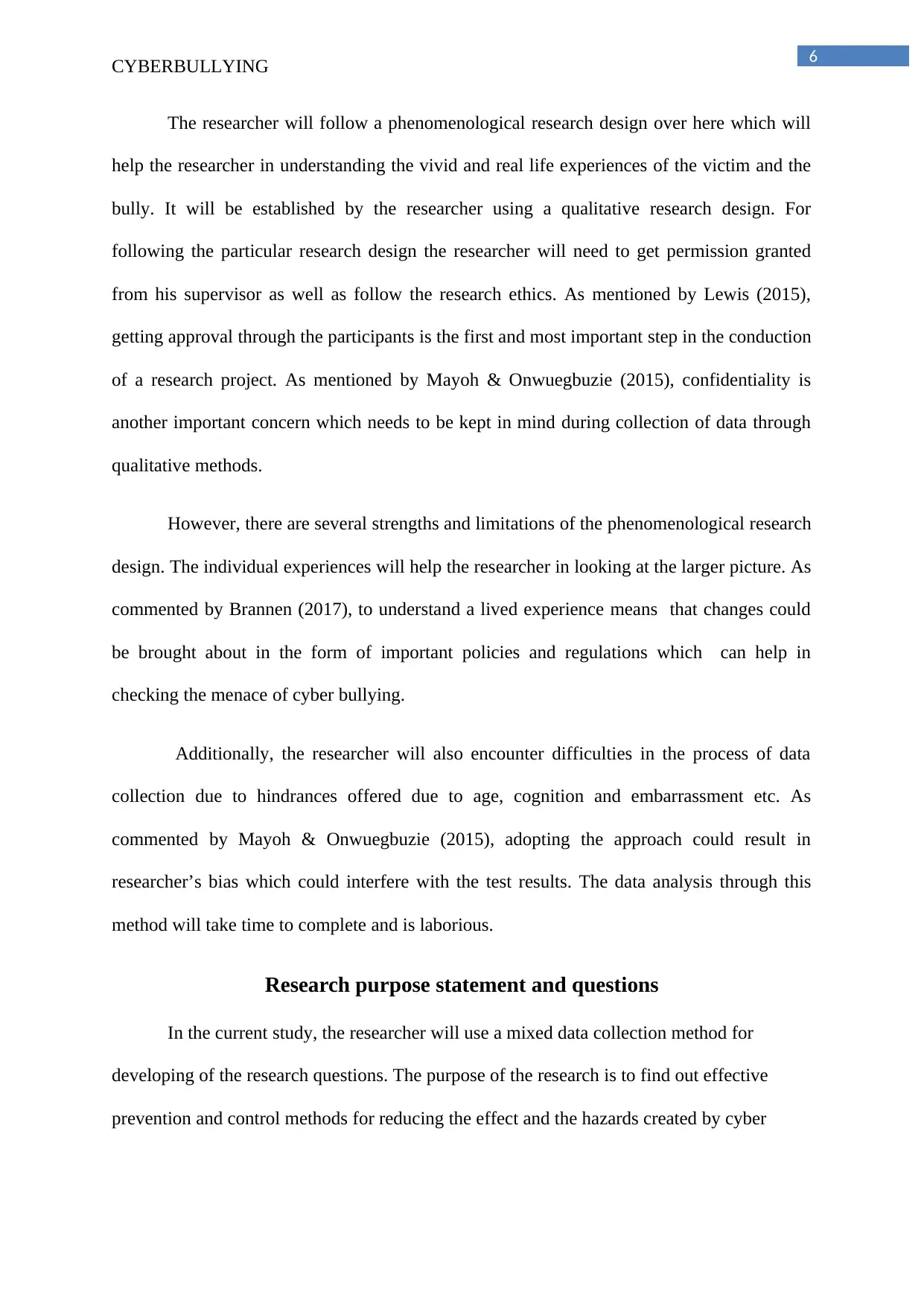
6
CYBERBULLYING
The researcher will follow a phenomenological research design over here which will
help the researcher in understanding the vivid and real life experiences of the victim and the
bully. It will be established by the researcher using a qualitative research design. For
following the particular research design the researcher will need to get permission granted
from his supervisor as well as follow the research ethics. As mentioned by Lewis (2015),
getting approval through the participants is the first and most important step in the conduction
of a research project. As mentioned by Mayoh & Onwuegbuzie (2015), confidentiality is
another important concern which needs to be kept in mind during collection of data through
qualitative methods.
However, there are several strengths and limitations of the phenomenological research
design. The individual experiences will help the researcher in looking at the larger picture. As
commented by Brannen (2017), to understand a lived experience means that changes could
be brought about in the form of important policies and regulations which can help in
checking the menace of cyber bullying.
Additionally, the researcher will also encounter difficulties in the process of data
collection due to hindrances offered due to age, cognition and embarrassment etc. As
commented by Mayoh & Onwuegbuzie (2015), adopting the approach could result in
researcher’s bias which could interfere with the test results. The data analysis through this
method will take time to complete and is laborious.
Research purpose statement and questions
In the current study, the researcher will use a mixed data collection method for
developing of the research questions. The purpose of the research is to find out effective
prevention and control methods for reducing the effect and the hazards created by cyber
CYBERBULLYING
The researcher will follow a phenomenological research design over here which will
help the researcher in understanding the vivid and real life experiences of the victim and the
bully. It will be established by the researcher using a qualitative research design. For
following the particular research design the researcher will need to get permission granted
from his supervisor as well as follow the research ethics. As mentioned by Lewis (2015),
getting approval through the participants is the first and most important step in the conduction
of a research project. As mentioned by Mayoh & Onwuegbuzie (2015), confidentiality is
another important concern which needs to be kept in mind during collection of data through
qualitative methods.
However, there are several strengths and limitations of the phenomenological research
design. The individual experiences will help the researcher in looking at the larger picture. As
commented by Brannen (2017), to understand a lived experience means that changes could
be brought about in the form of important policies and regulations which can help in
checking the menace of cyber bullying.
Additionally, the researcher will also encounter difficulties in the process of data
collection due to hindrances offered due to age, cognition and embarrassment etc. As
commented by Mayoh & Onwuegbuzie (2015), adopting the approach could result in
researcher’s bias which could interfere with the test results. The data analysis through this
method will take time to complete and is laborious.
Research purpose statement and questions
In the current study, the researcher will use a mixed data collection method for
developing of the research questions. The purpose of the research is to find out effective
prevention and control methods for reducing the effect and the hazards created by cyber
Paraphrase This Document
Need a fresh take? Get an instant paraphrase of this document with our AI Paraphraser
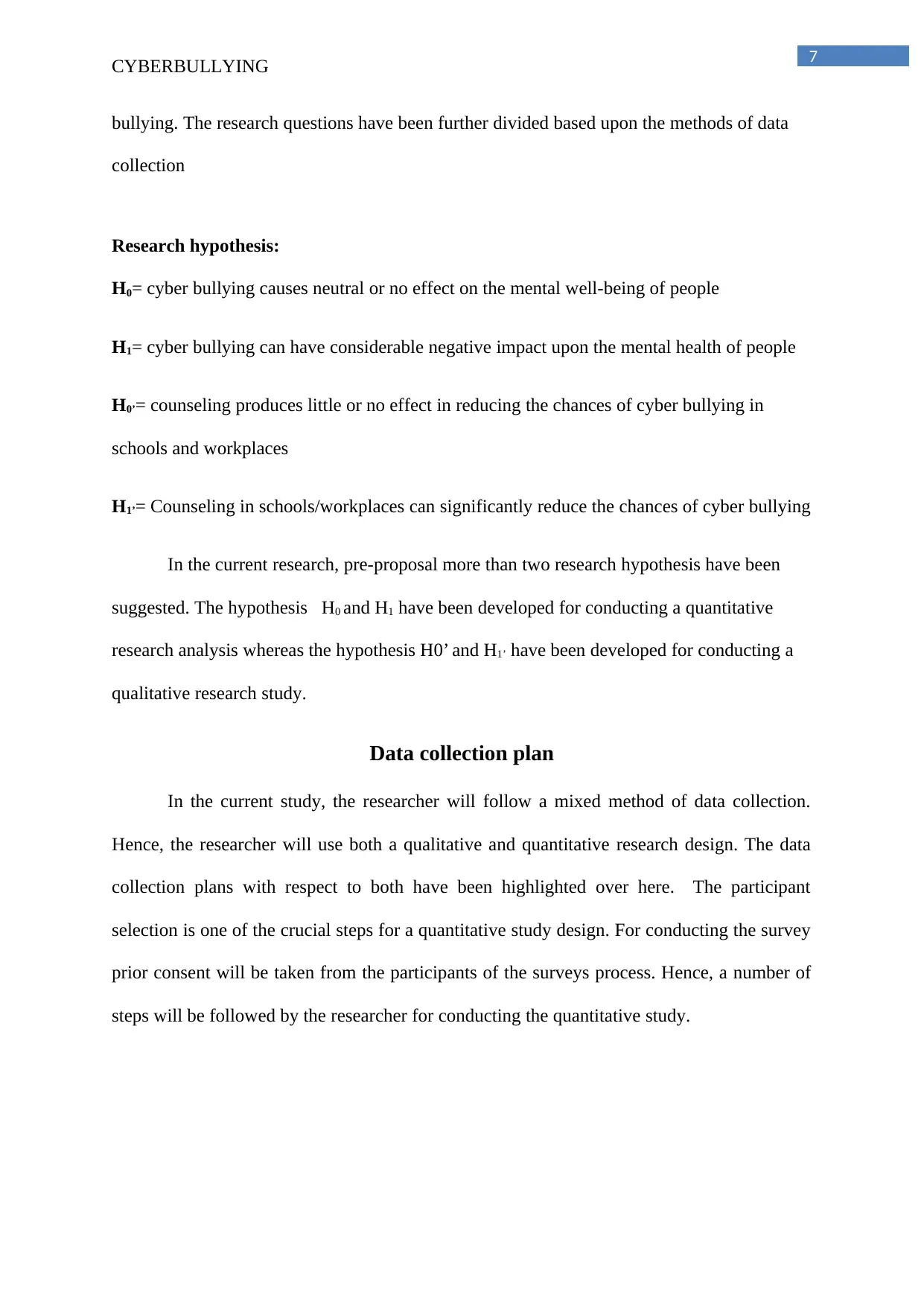
7
CYBERBULLYING
bullying. The research questions have been further divided based upon the methods of data
collection
Research hypothesis:
H0= cyber bullying causes neutral or no effect on the mental well-being of people
H1= cyber bullying can have considerable negative impact upon the mental health of people
H0’= counseling produces little or no effect in reducing the chances of cyber bullying in
schools and workplaces
H1’= Counseling in schools/workplaces can significantly reduce the chances of cyber bullying
In the current research, pre-proposal more than two research hypothesis have been
suggested. The hypothesis H0 and H1 have been developed for conducting a quantitative
research analysis whereas the hypothesis H0’ and H1’ have been developed for conducting a
qualitative research study.
Data collection plan
In the current study, the researcher will follow a mixed method of data collection.
Hence, the researcher will use both a qualitative and quantitative research design. The data
collection plans with respect to both have been highlighted over here. The participant
selection is one of the crucial steps for a quantitative study design. For conducting the survey
prior consent will be taken from the participants of the surveys process. Hence, a number of
steps will be followed by the researcher for conducting the quantitative study.
CYBERBULLYING
bullying. The research questions have been further divided based upon the methods of data
collection
Research hypothesis:
H0= cyber bullying causes neutral or no effect on the mental well-being of people
H1= cyber bullying can have considerable negative impact upon the mental health of people
H0’= counseling produces little or no effect in reducing the chances of cyber bullying in
schools and workplaces
H1’= Counseling in schools/workplaces can significantly reduce the chances of cyber bullying
In the current research, pre-proposal more than two research hypothesis have been
suggested. The hypothesis H0 and H1 have been developed for conducting a quantitative
research analysis whereas the hypothesis H0’ and H1’ have been developed for conducting a
qualitative research study.
Data collection plan
In the current study, the researcher will follow a mixed method of data collection.
Hence, the researcher will use both a qualitative and quantitative research design. The data
collection plans with respect to both have been highlighted over here. The participant
selection is one of the crucial steps for a quantitative study design. For conducting the survey
prior consent will be taken from the participants of the surveys process. Hence, a number of
steps will be followed by the researcher for conducting the quantitative study.

8
CYBERBULLYING
Participant Selection
For conducting the quantitative study, the researcher will select children from schools
and colleges as well as participants from workplaces who have faced incidences of cyber
bullying in the past. The researcher will meet the participants at the regional centre for mental
health. The participants will be divided into small focus groups which will help in conducting
the survey.
Gaining Permission
The researcher will get in touch with the schools and colleges of the children and a
consent form will be sent to the parents of the students who will be made part of the survey
process. The researchers will only conduct the survey after getting approval from the parents
and teachers of the children. The researcher will also obtain a no objection certificate from
the workplaces of the employee who have to undergo the study design.
Data to be Collected
The data collected will help in arriving at statistically significant results which will be
presented in the form of graphs and charts.
Data Collection Instruments
The data will be collected using close ended questionnaire where the researcher will
collect responses from the participants of the survey process.
The researcher will also use a qualitative research design where the researcher will
arrange an interview with his focus group of participants. The focus group will be divided
into the young adults and the office goers many of who have experienced workplace bullying.
In this respect, certain important factors for conducting the interview will also be taken into
account by the researcher.
Sampling Approach-
CYBERBULLYING
Participant Selection
For conducting the quantitative study, the researcher will select children from schools
and colleges as well as participants from workplaces who have faced incidences of cyber
bullying in the past. The researcher will meet the participants at the regional centre for mental
health. The participants will be divided into small focus groups which will help in conducting
the survey.
Gaining Permission
The researcher will get in touch with the schools and colleges of the children and a
consent form will be sent to the parents of the students who will be made part of the survey
process. The researchers will only conduct the survey after getting approval from the parents
and teachers of the children. The researcher will also obtain a no objection certificate from
the workplaces of the employee who have to undergo the study design.
Data to be Collected
The data collected will help in arriving at statistically significant results which will be
presented in the form of graphs and charts.
Data Collection Instruments
The data will be collected using close ended questionnaire where the researcher will
collect responses from the participants of the survey process.
The researcher will also use a qualitative research design where the researcher will
arrange an interview with his focus group of participants. The focus group will be divided
into the young adults and the office goers many of who have experienced workplace bullying.
In this respect, certain important factors for conducting the interview will also be taken into
account by the researcher.
Sampling Approach-
⊘ This is a preview!⊘
Do you want full access?
Subscribe today to unlock all pages.

Trusted by 1+ million students worldwide
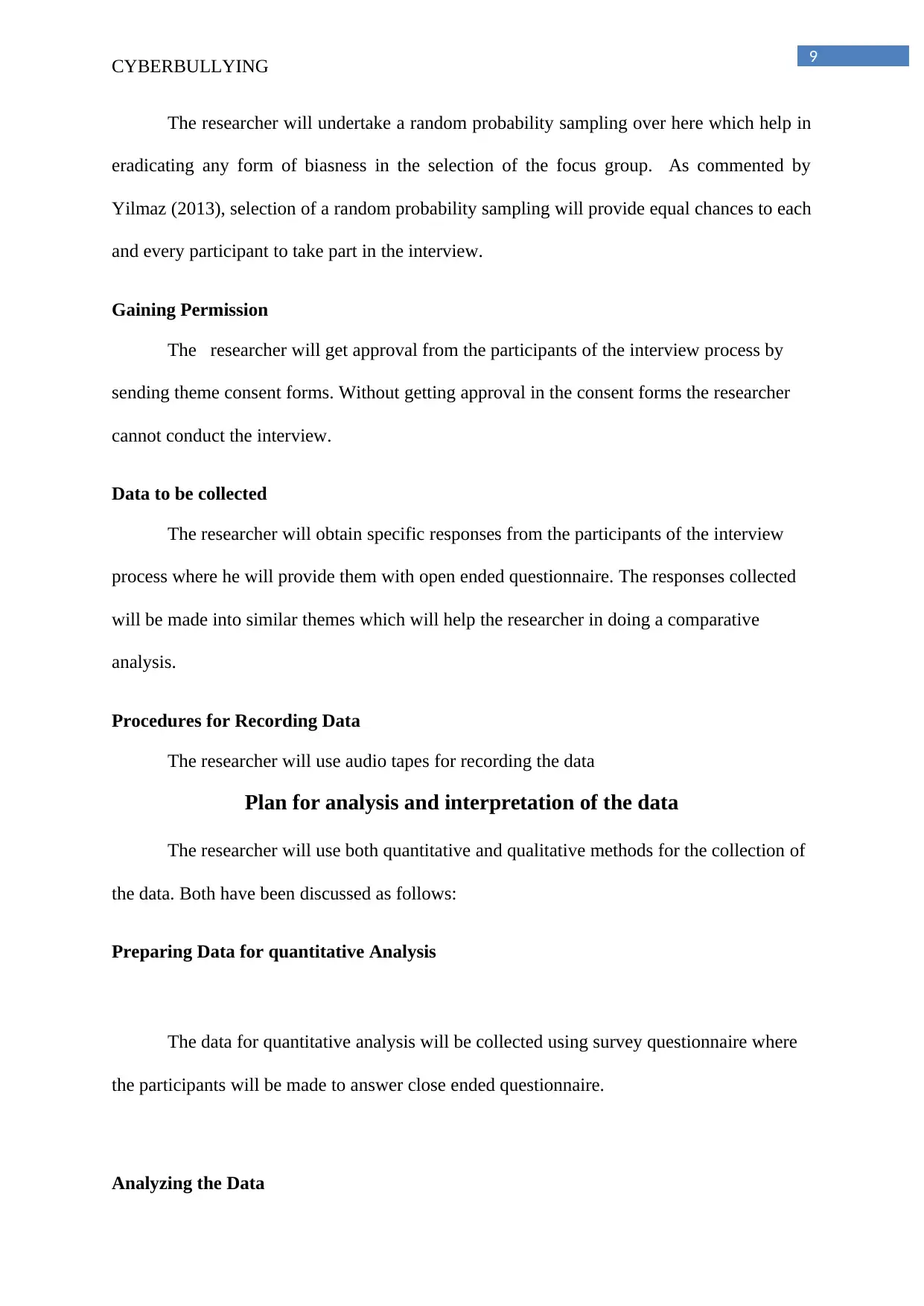
9
CYBERBULLYING
The researcher will undertake a random probability sampling over here which help in
eradicating any form of biasness in the selection of the focus group. As commented by
Yilmaz (2013), selection of a random probability sampling will provide equal chances to each
and every participant to take part in the interview.
Gaining Permission
The researcher will get approval from the participants of the interview process by
sending theme consent forms. Without getting approval in the consent forms the researcher
cannot conduct the interview.
Data to be collected
The researcher will obtain specific responses from the participants of the interview
process where he will provide them with open ended questionnaire. The responses collected
will be made into similar themes which will help the researcher in doing a comparative
analysis.
Procedures for Recording Data
The researcher will use audio tapes for recording the data
Plan for analysis and interpretation of the data
The researcher will use both quantitative and qualitative methods for the collection of
the data. Both have been discussed as follows:
Preparing Data for quantitative Analysis
The data for quantitative analysis will be collected using survey questionnaire where
the participants will be made to answer close ended questionnaire.
Analyzing the Data
CYBERBULLYING
The researcher will undertake a random probability sampling over here which help in
eradicating any form of biasness in the selection of the focus group. As commented by
Yilmaz (2013), selection of a random probability sampling will provide equal chances to each
and every participant to take part in the interview.
Gaining Permission
The researcher will get approval from the participants of the interview process by
sending theme consent forms. Without getting approval in the consent forms the researcher
cannot conduct the interview.
Data to be collected
The researcher will obtain specific responses from the participants of the interview
process where he will provide them with open ended questionnaire. The responses collected
will be made into similar themes which will help the researcher in doing a comparative
analysis.
Procedures for Recording Data
The researcher will use audio tapes for recording the data
Plan for analysis and interpretation of the data
The researcher will use both quantitative and qualitative methods for the collection of
the data. Both have been discussed as follows:
Preparing Data for quantitative Analysis
The data for quantitative analysis will be collected using survey questionnaire where
the participants will be made to answer close ended questionnaire.
Analyzing the Data
Paraphrase This Document
Need a fresh take? Get an instant paraphrase of this document with our AI Paraphraser
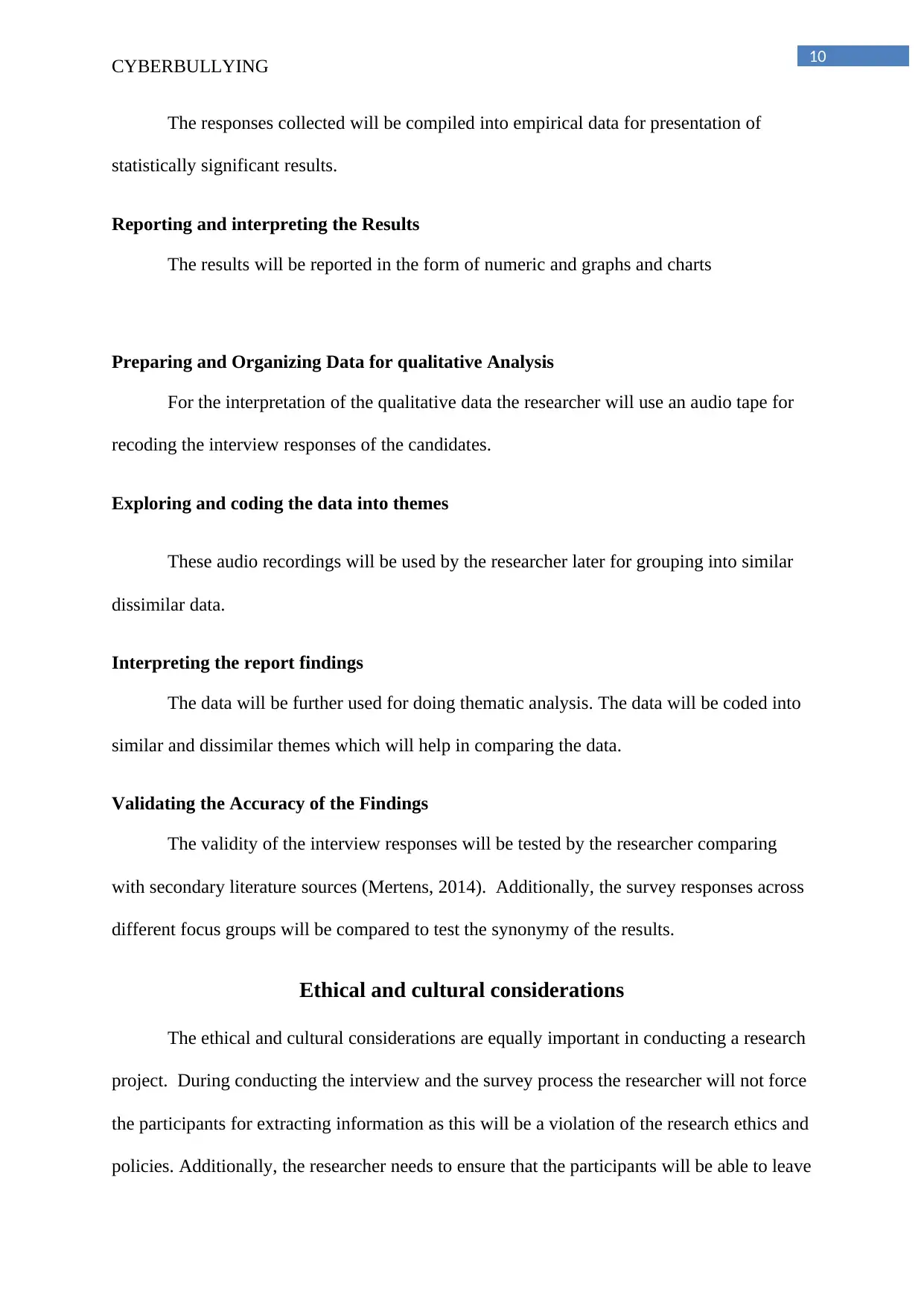
10
CYBERBULLYING
The responses collected will be compiled into empirical data for presentation of
statistically significant results.
Reporting and interpreting the Results
The results will be reported in the form of numeric and graphs and charts
Preparing and Organizing Data for qualitative Analysis
For the interpretation of the qualitative data the researcher will use an audio tape for
recoding the interview responses of the candidates.
Exploring and coding the data into themes
These audio recordings will be used by the researcher later for grouping into similar
dissimilar data.
Interpreting the report findings
The data will be further used for doing thematic analysis. The data will be coded into
similar and dissimilar themes which will help in comparing the data.
Validating the Accuracy of the Findings
The validity of the interview responses will be tested by the researcher comparing
with secondary literature sources (Mertens, 2014). Additionally, the survey responses across
different focus groups will be compared to test the synonymy of the results.
Ethical and cultural considerations
The ethical and cultural considerations are equally important in conducting a research
project. During conducting the interview and the survey process the researcher will not force
the participants for extracting information as this will be a violation of the research ethics and
policies. Additionally, the researcher needs to ensure that the participants will be able to leave
CYBERBULLYING
The responses collected will be compiled into empirical data for presentation of
statistically significant results.
Reporting and interpreting the Results
The results will be reported in the form of numeric and graphs and charts
Preparing and Organizing Data for qualitative Analysis
For the interpretation of the qualitative data the researcher will use an audio tape for
recoding the interview responses of the candidates.
Exploring and coding the data into themes
These audio recordings will be used by the researcher later for grouping into similar
dissimilar data.
Interpreting the report findings
The data will be further used for doing thematic analysis. The data will be coded into
similar and dissimilar themes which will help in comparing the data.
Validating the Accuracy of the Findings
The validity of the interview responses will be tested by the researcher comparing
with secondary literature sources (Mertens, 2014). Additionally, the survey responses across
different focus groups will be compared to test the synonymy of the results.
Ethical and cultural considerations
The ethical and cultural considerations are equally important in conducting a research
project. During conducting the interview and the survey process the researcher will not force
the participants for extracting information as this will be a violation of the research ethics and
policies. Additionally, the researcher needs to ensure that the participants will be able to leave
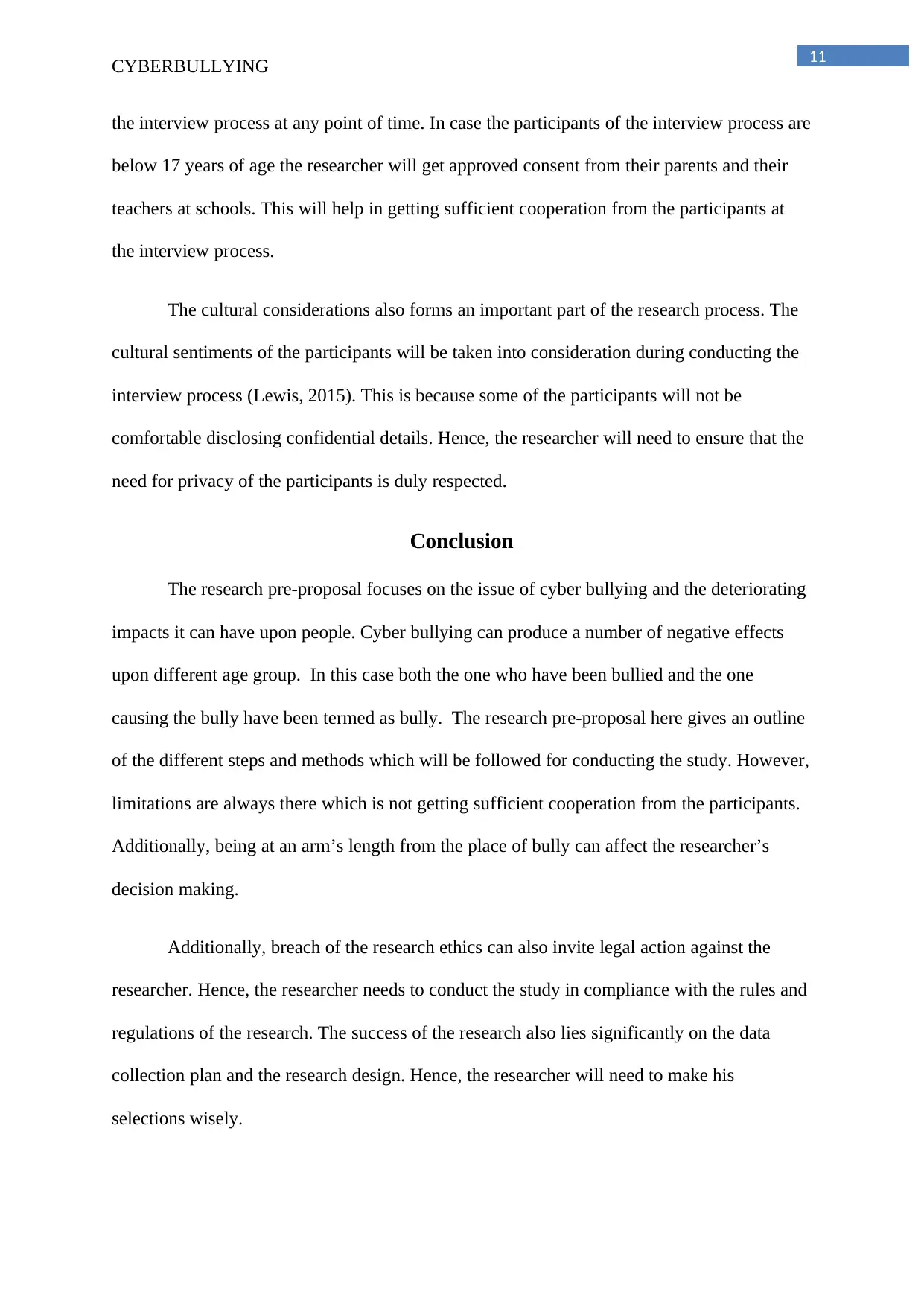
11
CYBERBULLYING
the interview process at any point of time. In case the participants of the interview process are
below 17 years of age the researcher will get approved consent from their parents and their
teachers at schools. This will help in getting sufficient cooperation from the participants at
the interview process.
The cultural considerations also forms an important part of the research process. The
cultural sentiments of the participants will be taken into consideration during conducting the
interview process (Lewis, 2015). This is because some of the participants will not be
comfortable disclosing confidential details. Hence, the researcher will need to ensure that the
need for privacy of the participants is duly respected.
Conclusion
The research pre-proposal focuses on the issue of cyber bullying and the deteriorating
impacts it can have upon people. Cyber bullying can produce a number of negative effects
upon different age group. In this case both the one who have been bullied and the one
causing the bully have been termed as bully. The research pre-proposal here gives an outline
of the different steps and methods which will be followed for conducting the study. However,
limitations are always there which is not getting sufficient cooperation from the participants.
Additionally, being at an arm’s length from the place of bully can affect the researcher’s
decision making.
Additionally, breach of the research ethics can also invite legal action against the
researcher. Hence, the researcher needs to conduct the study in compliance with the rules and
regulations of the research. The success of the research also lies significantly on the data
collection plan and the research design. Hence, the researcher will need to make his
selections wisely.
CYBERBULLYING
the interview process at any point of time. In case the participants of the interview process are
below 17 years of age the researcher will get approved consent from their parents and their
teachers at schools. This will help in getting sufficient cooperation from the participants at
the interview process.
The cultural considerations also forms an important part of the research process. The
cultural sentiments of the participants will be taken into consideration during conducting the
interview process (Lewis, 2015). This is because some of the participants will not be
comfortable disclosing confidential details. Hence, the researcher will need to ensure that the
need for privacy of the participants is duly respected.
Conclusion
The research pre-proposal focuses on the issue of cyber bullying and the deteriorating
impacts it can have upon people. Cyber bullying can produce a number of negative effects
upon different age group. In this case both the one who have been bullied and the one
causing the bully have been termed as bully. The research pre-proposal here gives an outline
of the different steps and methods which will be followed for conducting the study. However,
limitations are always there which is not getting sufficient cooperation from the participants.
Additionally, being at an arm’s length from the place of bully can affect the researcher’s
decision making.
Additionally, breach of the research ethics can also invite legal action against the
researcher. Hence, the researcher needs to conduct the study in compliance with the rules and
regulations of the research. The success of the research also lies significantly on the data
collection plan and the research design. Hence, the researcher will need to make his
selections wisely.
⊘ This is a preview!⊘
Do you want full access?
Subscribe today to unlock all pages.

Trusted by 1+ million students worldwide
1 out of 16
Related Documents
Your All-in-One AI-Powered Toolkit for Academic Success.
+13062052269
info@desklib.com
Available 24*7 on WhatsApp / Email
![[object Object]](/_next/static/media/star-bottom.7253800d.svg)
Unlock your academic potential
Copyright © 2020–2025 A2Z Services. All Rights Reserved. Developed and managed by ZUCOL.





